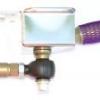Measuring something like bumpsteer is one thing, understanding why it was designed that way quite another. And it was designed that way, as it's quite easy to do it any other way you like. One thing about bumpsteer is that it's only interesting in the bump-droop interval that you really use. If you decrease that interval by mounting higher rate springs, you still have the same bumpsteer curve, but you're using a smaller interval in that curve. From that perspective it might even make sense to increase bumpsteer, bringing it back to the absolute values of the original interval, to stay within original design specs.
TBH, the more I look at it, the more I like my bicycle.
yes and no.
going stiffer does reduce the effects of bumpsteer, however, that's the sticking plaster approach as opposed to fixing the problem.
without a lot of changes, you cannot modify the bumpsteer curve, only the area in it that you are operating and the rate of change.
unless you're doing something out of the norm, the book setting for the rear is the way forward.
Front is a bit harder as it is (A) more subjective and ( dependant on a lot of other things,
dependant on a lot of other things,
ie. different construction tyres respond differently, so an optimum setup for one will be less than good on another.
I actually end up going by eye setup for the front then fine tune by what it feels like more than anything else, although this can be quite hard work to get spot on.






















